An oft-quoted adage speaks to the inevitability of death and taxes. Some people choose to meticulously plan their future to the extent of knowing their final resting place, the epitaph on their tombstones, and even the food served post the farewell ceremony. Others, however, prefer to place the concept of death on the backburner. However, the inescapable truth is that all of us, in some form or another, will eventually land in a grave. In certain parts of the world, this grave is marked by a tombstone bearing the name, birth date, and date of death. Depending on cultural customs and practices, there would be a caption, verse, or some enigmatic message inscribed. Yet, some individuals opt for more elaborate and memorable gravesites, either for themselves or for their departed loved ones. Some of these stand out visibly, some are uncanny, offbeat, and can even verge on being eerie.
These are 25 of the strangest and most unusual graves in the world.

The Woodplumpton Witch
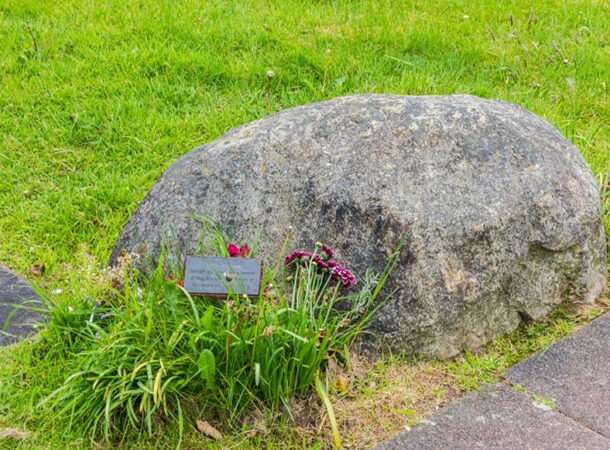 https://www.lancs.live/news/lancashire-news/woodplumpton-witch-buried-upside-down-22502060
https://www.lancs.live/news/lancashire-news/woodplumpton-witch-buried-upside-down-22502060 Not all graves are elaborate or romantic monuments. We decided to kick today’s list off with one cruelly memorialized and born from distrust. Meg Shelton, a 17th-century maid who earned a local reputation for witchcraft and deception, lies in the grave of the Woodplumpton Witch. She is supposed to have caused cattle illnesses, agricultural failures, turned herself into animals, and committed various other evil acts, in the process also earning her the moniker “the Fylde hag.” Meg died horribly, slammed against a wall by a barrel. While Meg is buried in consecrated ground, which is unusual for a woman branded a “witch,” she is buried upside down in what is known as a “deviant burial.” According to folklore, villagers buried her, only for her to repeatedly claw herself out of her grave. This resulted in Meg’s re-burial, head-first, underneath a massive boulder.
Love-struck in the Afterlife
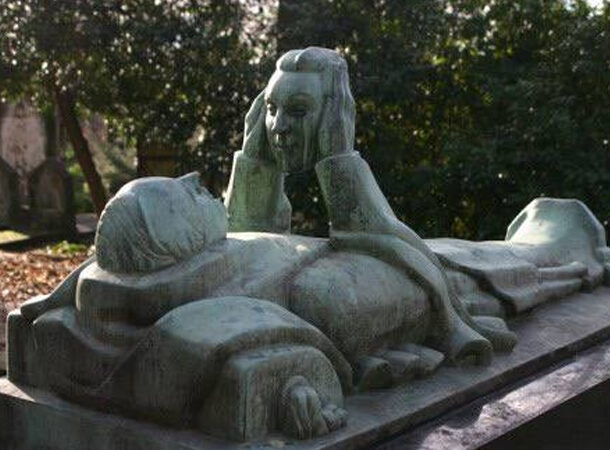 https://www.mrmartelo.com/fernand-arbelots-tombstone/
https://www.mrmartelo.com/fernand-arbelots-tombstone/ You will hear about the beautiful graves in France’s Père Lachaise cemetery in more than one item on our list today. Fernand Arbelot, an actor and pianist who died in 1942, has one such beautiful gravestone at the world-famous cemetery. Little is known about Arbelot, although it is believed that the face his bronze statue is clutching is that of his wife, whom he wished to look at for all eternity. Clearly, some of us want to be together even after death “do us part.”
Russia’s City of the Dead
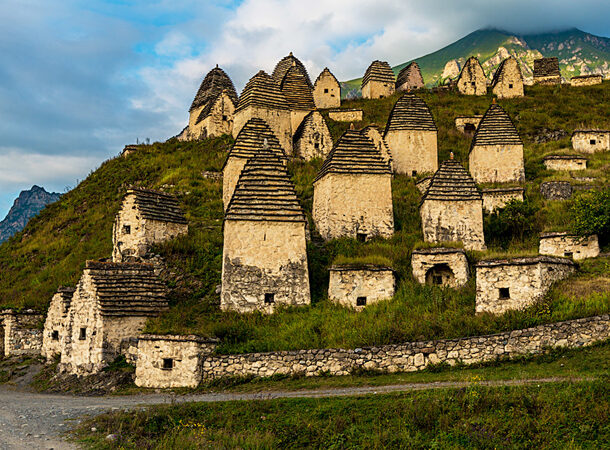 https://www.thetravel.com/city-of-the-dead-russia-visit/
https://www.thetravel.com/city-of-the-dead-russia-visit/ Russia’s City of the Dead lies within the Caucasus Mountains. It comprises a collection of peaked rooftops and single-window brick structures surrounded by scenic fields and tumbling clifftops. The City of the Dead, formally known as the village of Dargavs, is home to 10,000 graves. There are several theories as to how the city came to be. One theory holds that afflicted residents secluded themselves in single-window brick dwellings during a plague and waited for death. Another theory is that after the 13th-century Mongol-Tatar invasion, inhabitants living in the Caucasus mountain valley began creating house-like above-ground tombs to preserve space. According to a third theory, the City of the Dead was built by nomadic Sarmatians who established themselves in Southern Russia and interred their dead above the ground following Indo-Iranian tradition.
The Cadaver Tombs
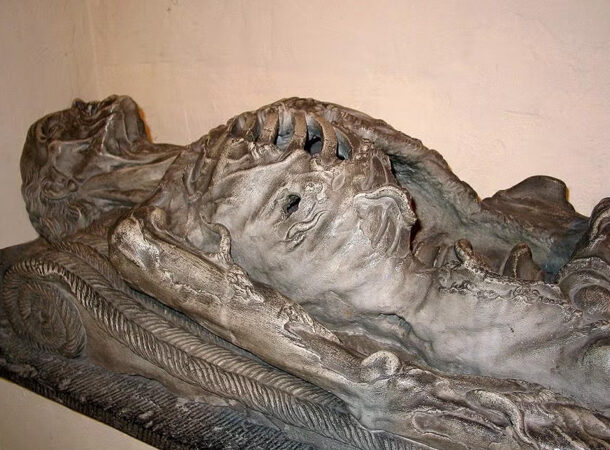 https://slate.com/human-interest/2014/09/transi-statues-and-cadaver-tombs-memento-mori-of-renaissance-europe.html
https://slate.com/human-interest/2014/09/transi-statues-and-cadaver-tombs-memento-mori-of-renaissance-europe.html The cadaver tombs of Europe, held behind the walls of numerous cathedrals and estates, are ancient, strange, and unsettling. Cadaver tombs were built in the rich tradition of “memento mori” – a reminder that you will die. Cadaver tombs often take this reminder too literally and depict a life-size representation of the deceased, clothed or draped in appropriate garments. The decomposing corpse of the deceased lays beneath this statue. Obviously, these massive tombs were only for the extremely affluent and influential. The two resident cadaver graves in Winchester portray Richard Fox and Stephen Gardiner, respectively. Both served as Bishop of Winchester in the 16th century and are now placed behind bars in the presbytery to keep curious tourists’ hands from wandering.
The Black Angel of Oakland Cemetery
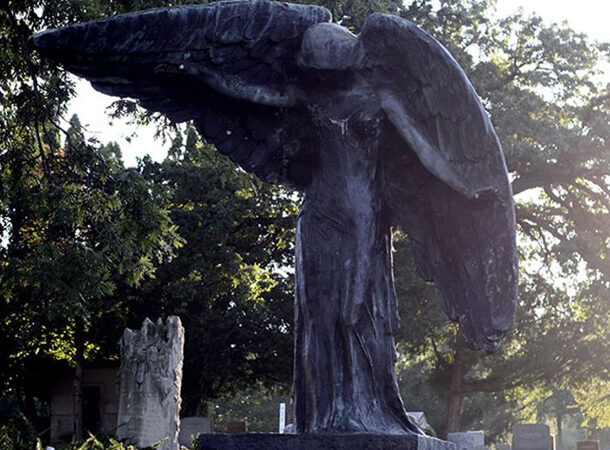 https://www.kcur.org/talk-show/2016-10-20/how-a-black-angel-statue-in-iowa-went-from-heartfelt-memorial-to-spooky-legend
https://www.kcur.org/talk-show/2016-10-20/how-a-black-angel-statue-in-iowa-went-from-heartfelt-memorial-to-spooky-legend The Oakland Cemetery’s Black Angel sits atop a gravestone that reads “Rodina Feldevertova,” which means “the Feldevert family” in Czech, and guards the remains of Teresa and Nicholas Feldevert, as well as Teresa’s son Eddie Dolezal. At over 13 feet tall, the statue commands attention. One winged arm is spread to the right, and the angel’s head is slumped down, peering down at the tomb below – it finds itself in a worthy spot on today’s list as it is rumored to haunt the cemetery. In fact, the Black Angel has been said to have the power to kill anyone who kisses (or, in some cases, touches) it. The bronze statue has also been reported to have turned black overnight for various reasons, ranging from a lightning strike to an indication of its owner’s infidelity. In any event, the Black Angel statue’s shadow is a genuinely terrifying monument.
The Artist’s Assistant and His Colorful Cat
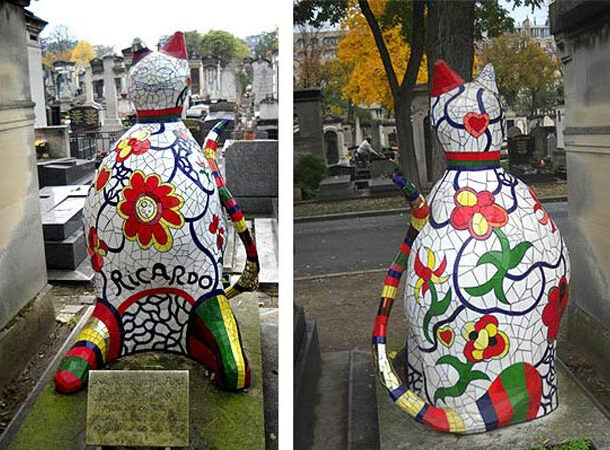 https://nikidesaintphalle.org/nikis-sculptures-le-cimetiere-de-montparnasse/
https://nikidesaintphalle.org/nikis-sculptures-le-cimetiere-de-montparnasse/ One very colorful creature can be found among the Victorian graves and granite tombstones of Paris’ Montparnasse Cemetery. One peculiar gravestone, known as Ricardo’s Cat, stands about 5 ft (1.5 meters) tall and is adorned with mosaic tiles. Niki de Saint Phalle created the odd headstone for her assistant, Ricardo Menon, who died in 1989 at the age of 37. The epitaph at the cat’s feet reads, “To our friend Ricardo who died too soon, beautiful, young and loved.”
A Home in the Cemetery
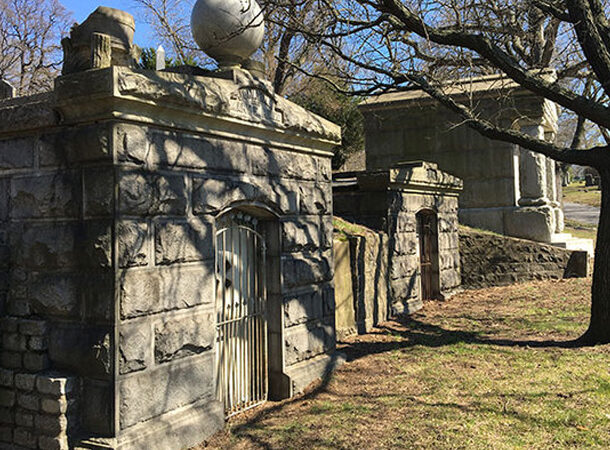 https://www.huffpost.com/entry/til-death-do-us-part-the_b_9781186
https://www.huffpost.com/entry/til-death-do-us-part-the_b_9781186 Jonathan Reed and his wife’s Brooklyn tomb is worthy of a place on our list. When Jonathan’s wife Mary died, he was devastated and moved into the vault that held his wife, where he stayed until his own death ten years later. Jonathan added an empty casket (for himself in the future), furniture, a wood stove, paintings, and other items. During Jonathan’s first year in the tomb, approximately 7,000 individuals came to pay him a visit, and he could often be seen speaking to Mary. Caretakers found him in 1905 with his arms still outstretched toward his wife’s grave.
The Baby Trees
 https://www.ancient-origins.net/ancient-places-asia/toraja-people-and-most-complex-funeral-rituals-world-001268
https://www.ancient-origins.net/ancient-places-asia/toraja-people-and-most-complex-funeral-rituals-world-001268 The remains of the youngest casualties in the Tana Toraja territory on an island in Indonesia are laid to rest in a special “burial tree”. Known as “baby trees” it has been used as the final resting place for infants for ages. But there is an age limit. Should a baby die before it starts teething, the mother wraps the child in a cloth and carve a hole in the tree. The baby is then placed inside the hole, and it is sealed off. It is believed that the tree absorbs the infant as it heals. It may seem morbid, but it is in actual fact quite beautiful.
A Grave for a Hungarian Heroine
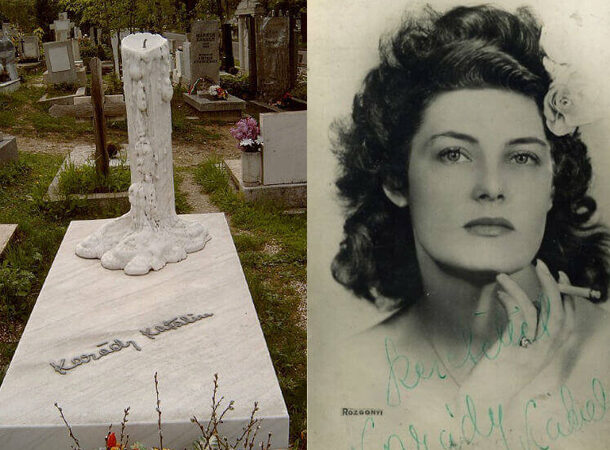 https://welovebudapest.com/en/article/2022/8/31/sights-culture-karady-show-honours-a-hungarian-legend
https://welovebudapest.com/en/article/2022/8/31/sights-culture-karady-show-honours-a-hungarian-legend Katalin Karády was a 1940s Hungarian film star celebrated for her heroic efforts to save Hungarian Jews during WWII. Even going so far as to hide children in her home, she was captured and imprisoned for three months in 1944 on suspicion of being an Allied spy. After the war, she traveled the world and finally settled in New York, where she opened a hat store. After her death, her remains were taken back to Hungary. Her grave in Budapest’s Farkasreti Cemetery bears a massive and finely carved sculpture resembling a melting candle, with a copy of her signature inscribed at its base. Katalin’s tomb has become a pilgrimage site for those wishing to pay tribute to the beautiful star’s bravery.
A Rocky Grave
 https://www.wral.com/nc-senator-buried-in-a-rock-has-hidden-gravesite-in-franklin-county/20211187/
https://www.wral.com/nc-senator-buried-in-a-rock-has-hidden-gravesite-in-franklin-county/20211187/ William Jeffreys was only 28 years old when he was elected to the North Carolina Senate in 1844. When he developed a fever approximately a year later, his term had just kicked off to a strong start. During his sickness, he hallucinated and developed a phobia of being buried and eaten by worms. As a result, he told everybody who paid attention that he wished to be buried in a rock. No one initially took him seriously because he was young, enthusiastic, and expected to recover from his fever. But as the days passed, Jeffreys’ health deteriorated, raising concerns about his life, and his father succumbed to his burial request. A stone mason worked on the rock for nearly a year. He also made a marble slab with an inscription in his memory. Unfortunately, the slab was damaged during shipping. It would be another year before the tomb was finished.
Inez Clarke Monument
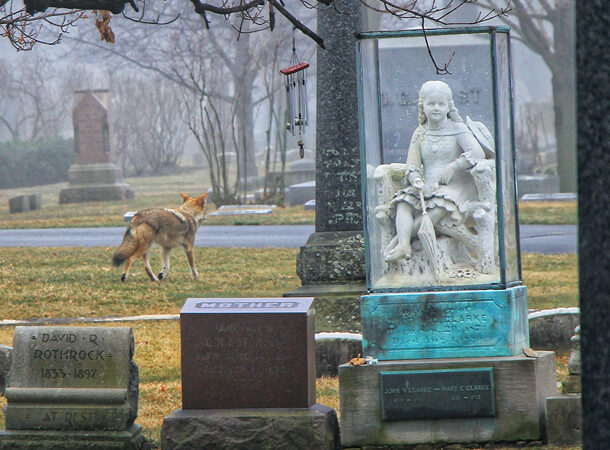 https://www.atlasobscura.com/places/inez-clarke-monument
https://www.atlasobscura.com/places/inez-clarke-monument The Inez Clarke Monument is an unusual and eerie memorial with very mysterious origins. A statue of a young girl on a pedestal, holding her parasol, wouldn’t ordinarily seem particularly creepy. However, this particular girl is encased in glass and is rumoured to be haunted. It is said that she comes to life whenever there’s stormy weather and that she wanders the cemetery until the storms blow over. Security guards and bus tour drivers have all claimed that the statue disappears at night before returning to its rightful spot in the morning. However, there is another mystery surrounding the monument. Who is buried there? Although the inscription states “Inez Clarke 1873-1880,” Helen Sclair, a Chicago cemetery specialist and authority in the field, previously noted that a boy called Amos Briggs was buried there, deepening the mystery.
Andy Warhol’s Multifaceted Grave
 http://www.earthcam.com/usa/pennsylvania/pittsburgh/warhol/
http://www.earthcam.com/usa/pennsylvania/pittsburgh/warhol/ At first sight, Andy Warhol’s grave in Pittsburgh, Pennsylvania, appears to be a standard gravestone. However, Warhol’s grave is live-streamed on the internet 24 hours a day, seven days a week. The continuous broadcasting of his grave began in 2013 to commemorate the artist’s 85th birthday. The live stream is part of the Figment art project. It was named after the artist, who once said he’d like his tombstone to remain blank – or actually to say “figment.” Webcam viewers can view the headstone at any time, day or night, rain or shine. Viewers can also look at the grave with a pop art filter, giving it Warhol’s trademark vibrant look. In celebration of his iconic artwork ‘Campbell’s Soup Cans,’ you can also pay to send a can of soup to his tomb, with all proceeds benefiting the Greater Pittsburgh Community Food Bank.
The Girl in the Shadow Box
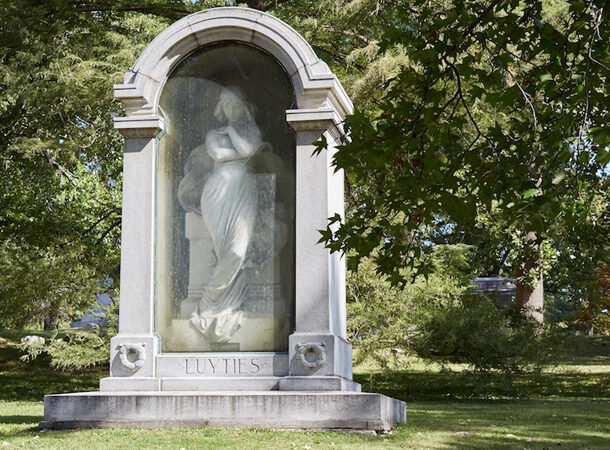 https://bellefontainecemetery.org/2021/09/28/herman-luyties/
https://bellefontainecemetery.org/2021/09/28/herman-luyties/ The Luyties family plot at Bellefontaine Cemetery in St. Louis, Missouri, is marked by a hauntingly beautiful headstone. Also known as “the girl in the shadow box,” – Herman Luyties commissioned the beautiful monument after falling deeply in love with the sculptor’s muse, an Italian model, while in Europe. Although she denied his marriage proposal, he had the statue of her moved to St. Louis and kept it in his home. It was eventually relocated to the family burial place in Bellefontaine Cemetery, where Herman erected a glass casing to safeguard his beloved from the elements. He died in 1921 at the age of 50 and was buried at her feet.
William Mackenzie’s Pyramid
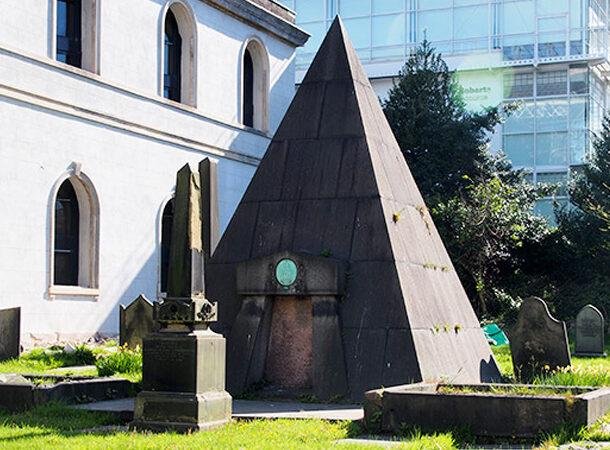 https://www.spookyisles.com/liverpool-pyramid/
https://www.spookyisles.com/liverpool-pyramid/ In the heart of Liverpool, just a few streets away from the bustling commercial district stands a 15 ft high pyramid. Although you might think it, t is not the final resting place of an Egyptian dignitary but that of a Victorian gambler. The stories about the inhabitant of the Liverpool Pyramid are mixed and diverse. Before his death, William Mackenzie gave precise orders that he be buried seated at a card table, holding a winning hand. However, many believe Mackenzie was not placed below the ground but left above ground with his winning hand to prevent Satan from stealing his soul. Whichever way his remains were left, a hunched poker-playing corpse inside a pyramid seems a lot more entertaining than a body in a coffin.
The Star-crossed Lovers
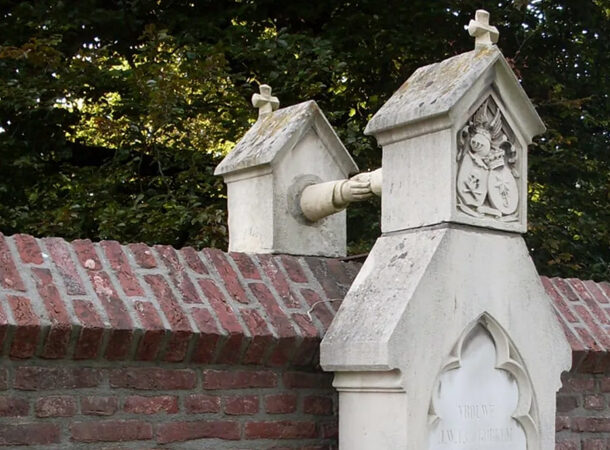 https://ucatholic.com/blog/the-sad-story-behind-this-catholic-grave-of-eternal-love/
https://ucatholic.com/blog/the-sad-story-behind-this-catholic-grave-of-eternal-love/ Colonel van Gorcum and Lady van Aefferden’s graves still hold hands over 150 years after their deaths. Lady van Aefferden was a noble Catholic, whereas the Colonel was a Protestant and a commoner when they married in 1842. Colonel van Gorcum died in 1880 and was buried in Roermond’s Protestant cemetery. Knowing she would be buried at a Catholic cemetery after her death, the Lady stated unequivocally that she wasn’t interested in being buried in her family’s plot. Instead, she chose a gravesite near the wall separating the two cemeteries, as close to her husband’s grave as possible. Two hands meet each other over the wall above their headstones, proving that acts of love can continue after we’re gone.
Victim of the Beast 666
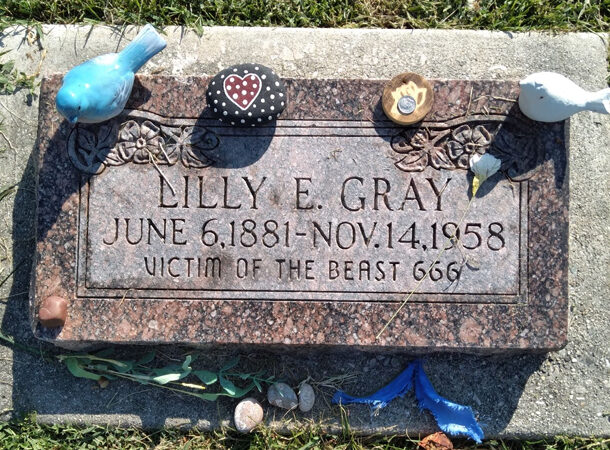 https://www.thedeadhistory.com/blog/lilly-gray-victim-of-the-beast-666-2
https://www.thedeadhistory.com/blog/lilly-gray-victim-of-the-beast-666-2 It is not every day that you come across a headstone claiming that its owner was a victim of the beast – 666. Many people are curious about Lily Edith Gray’s grave in Ontario, Canada, and wonder what exactly happened to this unfortunate lady. The internet’s most probable explanation for the epitaph’s meaning is that it came from her husband, Elmer Lewis Gray’s unstable mind, as he presumably procured the stone and was rumored to be a bit “off” at times. That, or we owe her our lives because she prevented what was about to happen to the rest of the world.
A Dancer’s Oriental Carpet
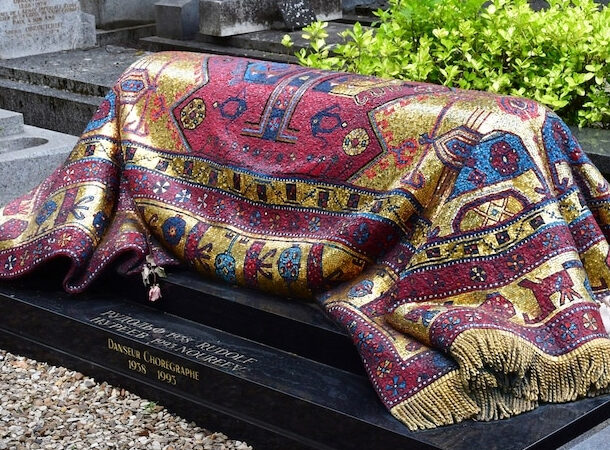 https://mymodernmet.com/rudolf-nureyev-tomb-sainte-genevieve-des-bois/
https://mymodernmet.com/rudolf-nureyev-tomb-sainte-genevieve-des-bois/ Rudolf Nureyev, popularly known as Lord of the Dance, was a legendary dancer and the partner of British ballerina Dame Margot Fonteyn. Nureyev, regarded as one of the most gifted dancers in living memory, died of heart complications in 1993. In his final years, he was the director and head choreographer of the Paris Opera Ballet. Nureyev was a connoisseur of beautiful carpets and tapestries and was buried wearing ballet shoes. His unique gravestone was made to look like a decadent oriental carpet. If you look closely, you’ll see that the “carpet” is actually made of little colorful mosaic tiles, the drapes and folds meticulously sculpted to create the beautiful effect.
Jay’s Grave
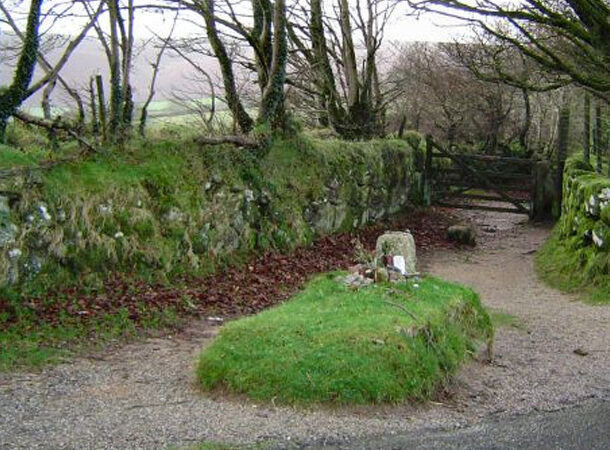 https://www.dartmoor.gov.uk/learning/dartmoor-legends/the-legend-of-jays-grave
https://www.dartmoor.gov.uk/learning/dartmoor-legends/the-legend-of-jays-grave Devonians have been perplexed by Jay’s Grave, a very unassuming grass mound for years. The grave is believed to be the resting place of a late-1700s suicide victim and has become a popular site for ghost hunters. Kitty Jay was refused a church grave on consecrated ground because of her religion-led humiliation towards suicide in the 18th century. Instead, she was buried at a crossroads so that her ghost would remain confused and never be able to find its way to the hereafter. Someone in the area does seem to have pity for Kitty since fresh flowers are frequently placed on her grave. Despite countless paranormal and other inquiries, no one has ever claimed responsibility for the frequent floral tributes.
A Burial Facing the Sky
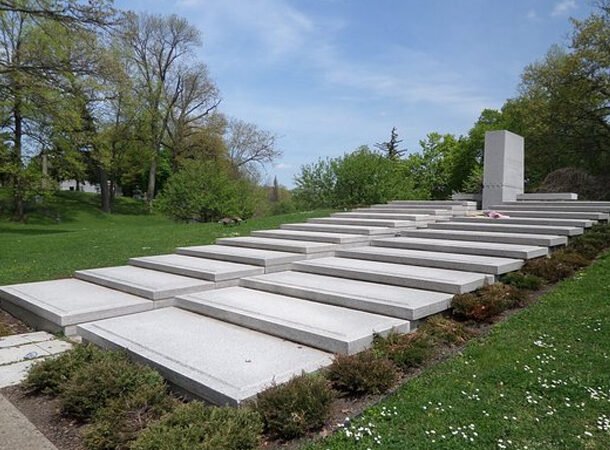 https://www.blueskymausoleum.com/
https://www.blueskymausoleum.com/ The Blue Sky Mausoleum can be seen at Forest Lawn Cemetery in Buffalo, New York. It was designed by revolutionary American architect Frank Lloyd Wright in honor of his close friend, Darwin D. Martin. The two friends had detailed discussions about the unusual mausoleum between 1925 and 1928, but it would not be finalized during either of their lives. In 2004, architect Anthony Puttnam, a former apprentice of Wright’s, collaborated with Forest Lawn Cemetery to make the two friends’ idea a reality. The design is based on comprehensive plans and blueprints by Wright, and the text was adopted as an epitaph from his message to Martin: “A burial facing the open sky…The whole could not fail of noble effect…”
The Grave that Continues to Grow
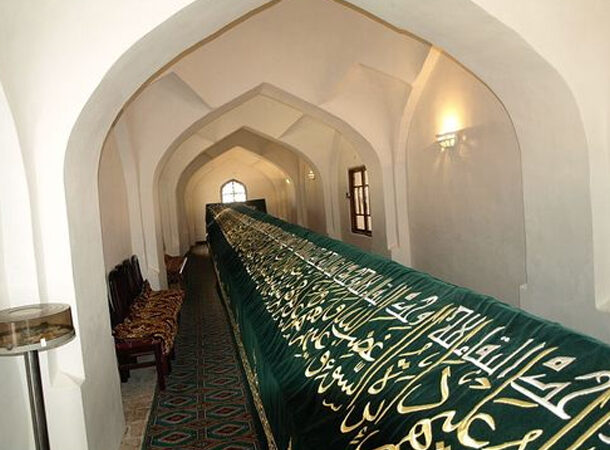 https://www.advantour.com/uzbekistan/legends/saint-daniel.htm
https://www.advantour.com/uzbekistan/legends/saint-daniel.htm One grave in Samarkand, Uzbekistan, has grown to incredible proportions over hundreds of years. It is believed to be the final resting place of the Old Testament prophet, Daniel, and local legend has it that his remains grew after death, resulting in a tomb that is now over 59 ft (18 meters) long. Timur, the Turco-Mongol leader who conquered Persia and Central Asia, is said to have placed Daniel’s remains at Samarkand for good luck. The reasoning behind the growing grave is that Timur became concerned about grave robbers and expanded the tomb to make it more difficult for them to steal the priceless human remains.
The Grave of Florence Irene Ford
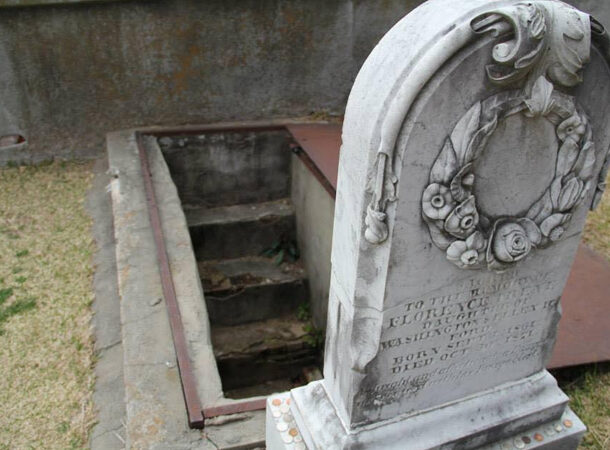 https://rare.us/rare-news/history/florence-irene-ford/
https://rare.us/rare-news/history/florence-irene-ford/ Florence Irene Ford died of yellow fever at age ten in 1871 and was laid to rest in Natchez City Cemetery in Adams County, Mississippi. Throughout her young life, she was terrified of storms and would run to her mother for comfort whenever one picked up. After her death, her mother requested that her tomb include a little glass panel at her daughter’s head. A touch creepy but not too much out of the ordinary. However, her mother then ordered the buried casket to be accessible through a stairway extending down approximately 6 ft (2 meters). Her mother also had a metal trapdoor placed at the top of the stairs so that she could close it during a storm and sit by her daughter, singing or reading to her until the storm passed.
Tragedy and Romance in Paris
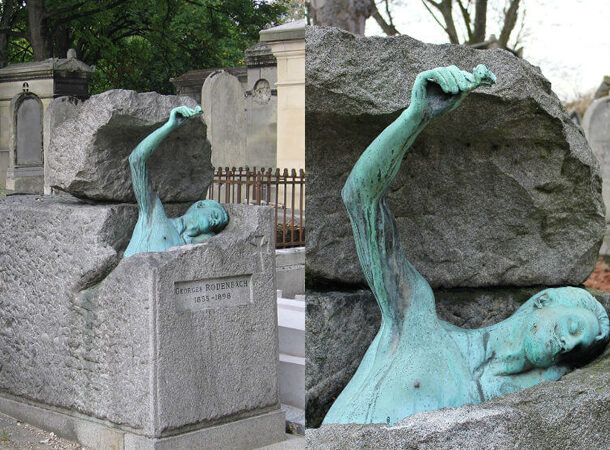 https://dangerousminds.net/comments/the_most_romantic_grave_in_pere_lachaise_cemetary
https://dangerousminds.net/comments/the_most_romantic_grave_in_pere_lachaise_cemetary There are hundreds of beautiful tombs at Le Père Lachaise, but one that will always stand out is the dramatic final resting place of Georges Rodenbach, a little-known writer and poet. Rodenbach is perhaps best known for his novel Bruges-la-Morte, which tells the melancholy story of a widower who travels the streets of Bruges struggling to come to terms with the death of his wife when he spots a woman who looks exactly like her. The novel is noteworthy because it was the first time photographs were included in a work of fiction. Rodenbach’s grave has a sculpture of him emerging from a big slab of rough-cut granite. His tomb symbolizes how even the grave cannot contain his spirit. Seemingly mocking death, he defiantly holds a single flower in his hand.
The “Get Rich Quick” Grave
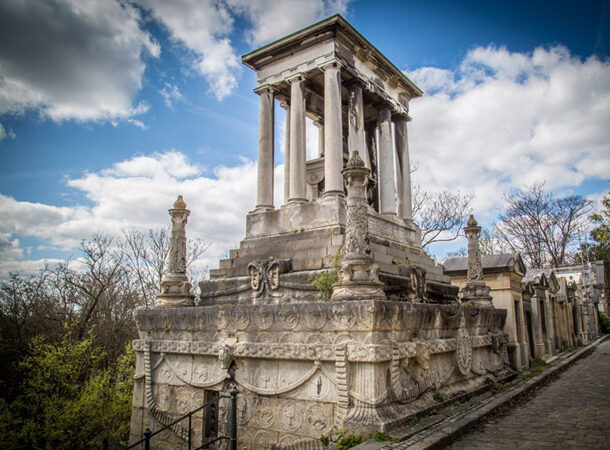 https://www.france-travel-info.com/most-mystical-tomb-in-pere-lachaise/
https://www.france-travel-info.com/most-mystical-tomb-in-pere-lachaise/ Elisabeth Demidoff was the descendant of a Russian family that made their fortune in salt and fur. She married the Russian Count Nikolai Nikitich Demidoff, heir to an industrialist fortune. Sadly, the marriage ended in divorce. After that, Elisabeth moved to Paris, where she died in 1818 at 40. While her life may not have been noteworthy, her dying request was a little creepy. According to legend, after her death, her relatives were astonished to learn that her will included a stipulation leaving millions of francs to anyone willing to spend a year and a day sitting beside her coffin in Paris’s Père Lachaise cemetery. Several people have attempted the feat to “get rich quick,” but no one has ever succeeded, despite requests continuing into the 1900s.
Peter the Wild Boy
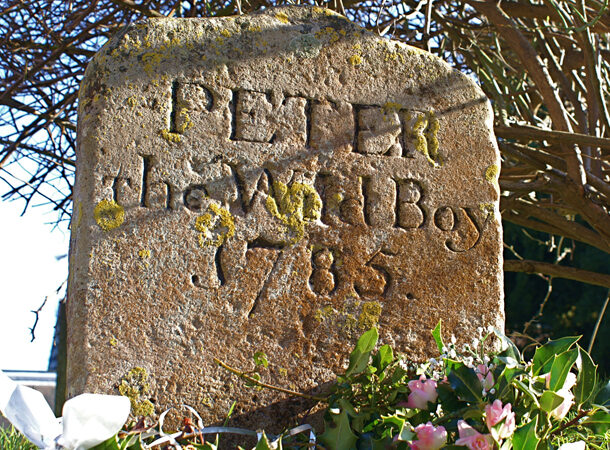 https://www.bbc.com/news/uk-england-beds-bucks-herts-21517995
https://www.bbc.com/news/uk-england-beds-bucks-herts-21517995 Peter was a ‘feral’ child in the woods near Hamelin, Germany. He was discovered by a hunting party of George I during a visit to his country and was brought back to the UK, where he quickly became a “court curiously.” He was placed in the care of court workers and given a living pension to help him survive, but he could never converse or fully integrate into the community. Peter couldn’t walk, had severe developmental problems, and had to be wrestled into a suit every day at court and preferred sleeping in a corner of his room rather than in a bed. Following an attempted escape in 1751, he was given a leather collar with his name on it to identify him if he ever wandered too far away from the estate. He died aged 70 and was buried with a small, basic tombstone on St Mary’s Church grounds. Despite its small stature, Peter’s grave is a constant reminder of the positive shift in views toward the disabled and those in need.
The Tomb of Cyrus the Great
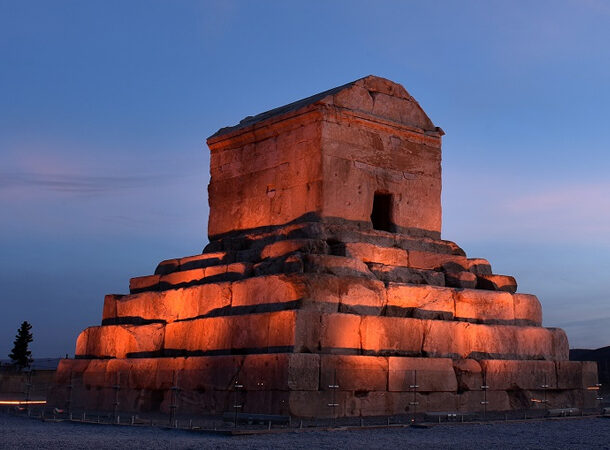 https://whc.unesco.org/en/list/1106/
https://whc.unesco.org/en/list/1106/ Cyrus the Great was the Achaemenid dynasty’s first king and the fourth king of Anshan. One of the first mentions of his tomb was in the writings of the Greek historian Aristobulus who journeyed alongside Alexander The Great during his military campaigns. It has been said that Alexander actually renovated the tomb; however, no evidence of such renovations has ever been found. Cyrus the Great was buried in a golden sarcophagus with his weapons, jewelry, and cloak. The distinctive tomb is the only grave on today’s list that is a UNESCO World Heritage site, and the monument includes the actual grave, a square room, and an attic. Despite countless centuries passing, the tomb remains hauntingly beautiful, and it takes the number one spot on today’s list.



























